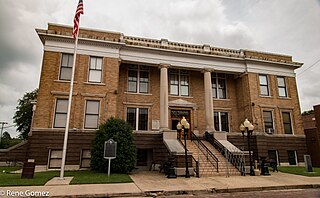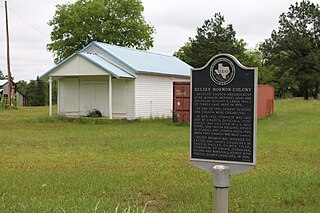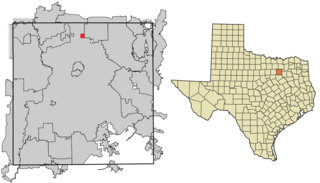
Wood County is a county located in the U.S. state of Texas. As of the 2020 census, its population was 44,843. Its county seat is Quitman. The county was named for George T. Wood, governor of Texas from 1847 to 1849.

Upshur County is a county located in the eastern part of the U.S. state of Texas. As of the 2020 census, the population was 40,892. The county seat is Gilmer. The county is named for Abel P. Upshur, who was U.S. Secretary of State during President John Tyler's administration.

Marion County is a county located in the U.S. state of Texas. As of the 2020 census, its population was 9,725. Its county seat is Jefferson. Marion County is in East Texas and is named for Francis Marion, the Revolutionary War general from South Carolina who was nicknamed the "Swamp Fox".

Harrison County is a county on the eastern border of the U.S. state of Texas. As of the 2020 United States census, its population was 68,839. The county seat is Marshall. The county was created in 1839 and organized in 1842. It is named for Jonas Harrison, a lawyer and Texas revolutionary.

Gregg County is a county located in the eastern part of the U.S. state of Texas. As of the 2020 census, its population was 124,239. Its county seat is Longview. The county is named after John Gregg, a Confederate general killed in action during the American Civil War.

Camp County is a county in the eastern part of Texas. As of the 2020 census, its population was 12,464. Its seat is Pittsburg. The county was founded in 1874 and is named for John Lafayette Camp, a Texas politician.

Yalobusha County is a county located in the U.S. state of Mississippi. As of the 2020 census, the population was 12,481. It has two county seats, Water Valley and Coffeeville.

Big Sandy is a town in Upshur County, Texas, United States. As of the 2020 census, the town's population was 1,231. A lake of the same name is cut nearly in half by U.S. Highway 80, the main thoroughfare of Big Sandy. It lies directly west of the larger cities of Gladewater and Longview.
Ore City is a city in Upshur County, Texas, United States. The population was 1,108 at the 2020 census.

Van is a city located in southeastern Van Zandt County, Texas, United States, approximately 26 miles northwest of Tyler. Its population was 2,632 at the 2010 census. The town draws its name from an early settler and school teacher, Henry Vance.
Clarksville City is a city in Gregg and Upshur counties in the U.S. state of Texas. The population was 780 at the 2020 census.

Gladewater is a city in Gregg and Upshur counties in the U.S. state of Texas with a 2020 census population of 6,134.

Shiloh is a small unincorporated farming community on Shiloh Road near White Oak in north central Gregg County, Texas, United States. Located just south of the Upshur County line, Shiloh was established by formerly enslaved African Americans just after the end of the Civil War.
Enoch is an unincorporated community in Upshur County, Texas, United States.

Kelsey is an unincorporated area in Upshur County, Texas, United States that was the longest-lasting settlement founded by members of the Church of Jesus Christ of Latter-day Saints in the state. Now a ghost town, it has been called the "mother colony" of Latter-day Saint colonies in Texas.
Sacul is an unincorporated community in Nacogdoches County, Texas, United States. According to the Handbook of Texas, the community had an estimated population of 170 in both 1990 and 2000.
Preston, also known as Preston Bend, is an unincorporated community and census-designated place located on the Red River in Grayson County, Texas, United States. It grew in the 19th century at the intersection of several military and trade roads and was an important crossing on the Shawnee cattle trail. Preston lost prominence after the MK&T railroad bypassed the town to the east, leading to a decline in traveler and cattle drive traffic. Much of its former town site is submerged beneath the waters of Lake Texoma. Its population was 2,096 as of the 2010 census.
Mixon is a small unincorporated community in northern Cherokee County, Texas, United States. According to the Handbook of Texas, the community had a population of 50 in 2000. It is located within the Tyler-Jacksonville combined statistical area.

Alpha was an unincorporated freedmen's town in Dallas County, Texas, United States. Founded soon after the American Civil War, the town peaked in the 1890s then dwindled in population throughout the 20th century before being delisted as a community in 1987. The area is now an incorporated part of the city of Dallas.